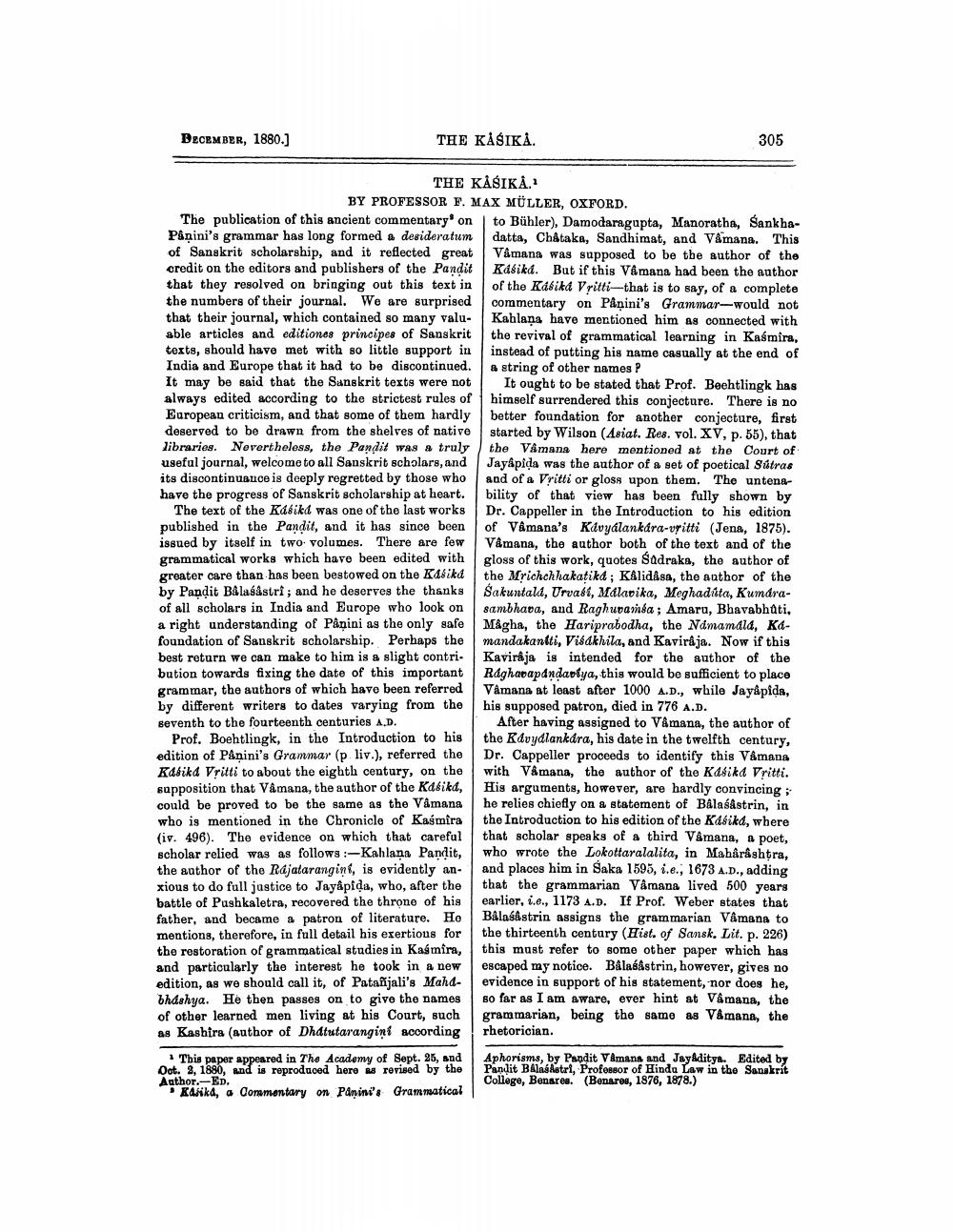________________
BECEMBER, 1880.]
THE KASIKA.
THE KASIKA.1 BY PROFESSOR F. MAX MÜLLER, OXFORD.
The publication of this ancient commentary on Pânini's grammar has long formed a desideratum of Sanskrit scholarship, and it reflected great credit on the editors and publishers of the Pandit that they resolved on bringing out this text in the numbers of their journal. We are surprised that their journal, which contained so many valuable articles and editiones principes of Sanskrit texts, should have met with so little support in India and Europe that it had to be discontinued. It may be said that the Sanskrit texts were not always edited according to the strictest rules of European criticism, and that some of them hardly deserved to be drawn from the shelves of native libraries. Nevertheless, the Pandit was a truly useful journal, welcome to all Sanskrit scholars, and its discontinuance is deeply regretted by those who have the progress of Sanskrit scholarship at heart.
The text of the Kásikd was one of the last works published in the Pandit, and it has since been issued by itself in two volumes. There are few grammatical works which have been edited with greater care than has been bestowed on the Kasika by Pandit Bâlasâstri; and he deserves the thanks of all scholars in India and Europe who look on a right understanding of Panini as the only safe foundation of Sanskrit scholarship. Perhaps the best return we can make to him is a slight contribution towards fixing the date of this important grammar, the authors of which have been referred by different writers to dates varying from the seventh to the fourteenth centuries A.D.
Prof. Boehtlingk, in the Introduction to his edition of Panini's Grammar (p. liv.), referred the Kábika Vritti to about the eighth century, on the supposition that Vâmana, the author of the Kdéika, could be proved to be the same as the Vâmana who is mentioned in the Chronicle of Kasmira (iv. 496). The evidence on which that careful scholar relied was as follows:-Kahlana Pandit, the author of the Rajatarangint, is evidently anxious to do full justice to Jayâpida, who, after the battle of Pushkaletra, recovered the throne of his father, and became a patron of literature. Ho mentions, therefore, in full detail his exertions for the restoration of grammatical studies in Kasmira, and particularly the interest he took in a new edition, as we should call it, of Patanjali's Mahdbhashya. He then passes on to give the names of other learned men living at his Court, such as Kashira (author of Dhdtutarangini according
This paper appeared in The Academy of Sept. 25, and Oct. 2, 1880, and is reproduced here as revised by the Author.-ED.
Kasika, a Commentary on Panini's Grammatical
305
to Bühler), Damodaragupta, Manoratha, Sankhadatta, Châtaka, Sandhimat, and Vamana. This Vâmana was supposed to be the author of the Kábika. But if this Vâmana had been the author of the Kábika Vritti-that is to say, of a complete commentary on Panini's Grammar-would not Kahlana have mentioned him as connected with the revival of grammatical learning in Kasmira, instead of putting his name casually at the end of a string of other names?
It ought to be stated that Prof. Beehtlingk has himself surrendered this conjecture. There is no better foundation for another conjecture, first started by Wilson (Asiat. Res. vol. XV, p. 55), that the Vâmana here mentioned at the Court of Jayâpida was the author of a set of poetical Sútras and of a Vritti or gloss upon them. The untenability of that view has been fully shown by Dr. Cappeller in the Introduction to his edition of Vâmana's Kávyálankára-vritti (Jena, 1875). Vâmana, the author both of the text and of the gloss of this work, quotes Sadraka, the author of the Mrichchhakatiká; Kâlidâsa, the author of the Sakuntala, Urvasi, Malavika, Meghadita, Kumárasambhava, and Raghuvamsa; Amaru, Bhavabhuti. Magha, the Hariprabodha, the Námamála, Kámandakantti, Visakhila, and Kaviraja. Now if this Kaviraja is intended for the author of the Raghavapandaviya, this would be sufficient to place Vamana at least after 1000 A.D., while Jayâpida, his supposed patron, died in 776 A.D.
After having assigned to Vâmana, the author of the Kdvydlankára, his date in the twelfth century, Dr. Cappeller proceeds to identify this Vâmana with Vamana, the author of the Kašika Vritti. His arguments, however, are hardly convincing; he relies chiefly on a statement of Bâlasâstrin, in the Introduction to his edition of the Kdéikd, where that scholar speaks of a third Vâmana, a poet, who wrote the Lokottaralalita, in Maharashtra, and places him in Saka 1595, i.e., 1673 A.D., adding that the grammarian Vâmana lived 500 years earlier, i.e., 1173 A.D. If Prof. Weber states that Bâlas&strin assigns the grammarian Vâmana to the thirteenth century (Hist. of Sansk. Lit. p. 226) this must refer to some other paper which has escaped my notice. Bâlaéâstrin, however, gives no evidence in support of his statement, nor does he, so far as I am aware, ever hint at Vâmana, the grammarian, being the same as Vamana, the rhetorician.
Aphorisms, by Pandit Vamana and Jayaditya. Edited by Pandit Balasastri, Professor of Hinda Law in the Sanskrit College, Benares. (Benares, 1876, 1878.)




